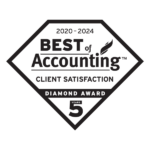You have gone through the process of applying with your bank for the Paycheck Protection Program (PPP) and you’ve been approved. Now, what should you do with the money?
As you recall, when applying for this loan, there is an opportunity to have 100% of the loan forgiven and, unlike other loans, having this loan forgiven will not be taxed for federal income tax purposes. The states are still considering the impact of the loan forgiveness, but you still need to focus on maximizing the forgiveness offered.
Spending the Funds
Once the first installment of the loan proceeds is received from your lender, you have eight weeks to spend the money on qualifying expenses. In order to qualify for loan forgiveness, proceeds of the PPP may be used for:
- Payroll costs as defined in the Coronavirus Aid, Relief, and Economic Security Act (“CARES Act”)
- Continuation costs of group health care benefits
- Payment of retirement benefits
- Rent and utilities
- Mortgage interest payments on real and personal property (but not for prepayments or principal payments)
- Interest payments on other debt incurred before February 15, 2020 (although these amounts are not eligible for forgiveness)
- Refinancing a SBA EIDL Loan
Documentation for the PPP and Loan Forgiveness
The first thing an organization should do is speak with their lender and understand what the lender will require after the eight weeks to substantiate the loan forgiveness. Organizations will need to provide the documentation to the lender at the end of the eight weeks.
One way that companies can segregate the funds is to set up a separate bank account to easily track the usage of funds. In addition, consider adding detail to your accounting system to track related costs separately, by either creating a special designation in your general ledger or by a unique identifier in the account number. As soon as the money is received, and the eight week period begins, all eligible expenses should be tagged to the new accounts or cost centers. Make sure the accounting department retains any additional documentation that the lender requires and that you might not already routinely track. Also consider having preliminary discussions with your payroll provider to ensure that you can easily extract any required payroll information, or if payroll is maintained in-house, evaluate what you will need to track separately.
Employee Count and Compensation
Full loan forgiveness will require the organization to maintain employee headcount AND compensation levels or eliminate any reductions that occurred prior to April 26, 2020.
For additional information on the provisions related to headcount and compensation leve.s, see Schneider Downs’ previous Our Thoughts On article: Paycheck Protection Program – Loan Forgiveness at:
/our-thoughts-on/paycheck-protection-program-loan-forgiveness
Applying for Loan Forgiveness
After the eight-week period is over, you will need to submit a request to the lender who is servicing the PPP loan. The request should include all documents supporting the funds that were spent, number of employees and compensation levels. The lender will have 60 days to decide on forgiveness. We recommend being in communication with the lender early and often to determine the lender’s required or expected loan forgiveness documents and procedures. As with most of the content within the CARES Act, we expect the required documentation requirement to continue to evolve in the near term, and so we encourage you to maintain all documentation, and to apply additional scrutiny to all proceeds spent using PPP Funds.
Schneider Downs is here to provide support for you and your organization during this volatile period.
Please visit our Coronavirus resource page at schneiderdowns.com/our-thoughts-on/category/Coronavirus for related content.




